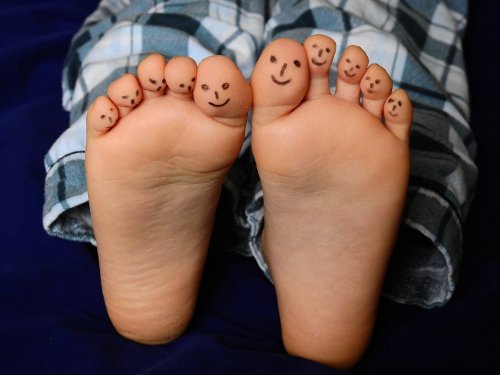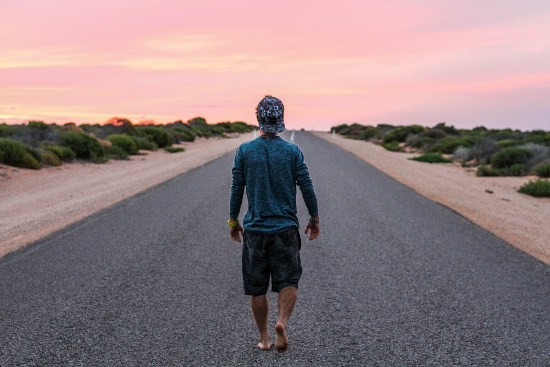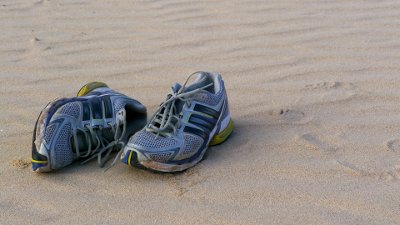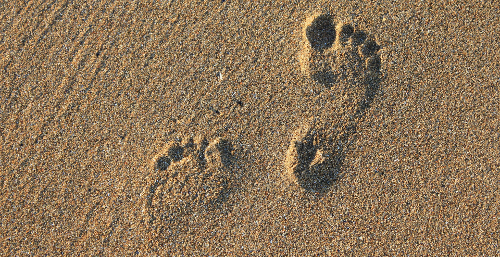Barefoot walking and running – a way to learn body awareness, become relaxed and build a healthier body. (Part 2 – Common myths about barefoot walking and running)
This is part two in my series of articles about barefoot walking and running. In the first one, which you can find here, I wrote about my experience and how I healed my injured knee through walking in minimalistic shoes. This second part will be busting some common myths that I either have believed myself or heard from others.

When I talk to other people about my experiences with barefoot walking I sometimes get to hear that it is dangerous or not everyone can do it or, the most common of them all, you will need to build up really hard feet to be an efficient barefoot walker or runner. I believed some of this stuff as well before I started walking barefoot and most of my beliefs have changed by actually experiencing and experimenting with it.
Before I get into myth busting I should explain what I mean with “barefoot walking /running”. In my first article I wrote that I healed my knee by walking in minimalistic shoes and that’s not barefoot, right?
For me barefoot walking means two things: 1) To actually walk barefoot, i.e without any shoes at all and 2) To walk in minimalistic shoes meant to be as non-intrusive as possible. Sometimes these two produce the same, or almost the same, result and sometimes there is world of difference between them. I will start to explore this subject here in this article and go deeper into it in the articles to come.
So here we go, common myths about barefoot walking or running and busting them from my experience.
- Barefoot walking or running relies on you getting hard feet, otherwise it will pain you too much.
- It’s dangerous to run or walk barefoot and we need the shoe padding to support our feet.
- Barefoot running/ walking isn’t for everyone.
I will go through the one by one.

Myth 1: Barefoot walking or running relies on you getting hard feet, otherwise it will pain you too much.
This myth has two parts in it, hard feet and pain, and my experience is that these actually are two separate points and not necessarily linked to each other as I believed before I started experimenting.
Since I was trying to use barefoot walking as grounding tool in the beginning, it meant that I had to try to be relaxed to be able to get the desired effect from it. And what I discovered was that when I managed to be relaxed while walking, the pain in the feet from walking on pebbles disappeared! The moment I tensed myself again my feet started to hurt. In my experimentations, I even managed to walk over a bramble plot, several meters (yards) wide, without problems, just by breathing and keeping my body and feet relaxed! That was quite a revolutionary experience for me as you can imagine. As I have kept practicing on being relaxed while moving I also managed, some years later, to put my 2km running track on a pebbled dirt road, without sore feet when I arrived home. So, I had my first understanding that what primarily hurts my feet walking without shoes is my own tension, not the ground.
Later on, when I started to walk barefoot or in minimalistic shoes all the time, I came to see that hard soles are not a sign that my feet are toughing up but an indication that I either use my body incorrectly when I walk or that my shoes force my feet to move unnaturally or be in an unnatural position. When I with time corrected my body posture and changed to minimalist shoes full-time the days of hard feet also disappeared. Nowadays my feet are always smooth as a baby’s and I can walk long distances without shoes.
Myth 2: It’s dangerous to run or walk barefoot and we need the shoe padding to support and protect our feet.
One guy that I talked with about barefoot running got seriously worried about me and said that I would probably injure myself if I didn’t have padded shoes. I also used to believe in this myth and was the first to buy shoes with a good (padded) support and no low-quality whimsical shoes. But after my experience with minimalistic shoes and what it did to me, I started to read more about it. And one article hit the nail straight on: Our feet are constructed to be walking without shoes. If it was dangerous, how did the human race survive up until the mid-20th-century, when the first padded shoes came out? Because, believe it or not, it’s only the last 70 years or so that shoes with a lot of support have existed. Before that, we walked either barefoot or with non-padded shoes. And obviously survived.
Part of this myth is that those with flat feet and high arcs really need the support of real shoes. I won’t go in too much in this because I never had this problem (and therefore cannot speak from experience), but I have read and heard about a lot of people who tossed away their support or inserts after starting to walk barefoot or in minimalistic shoes. The flat feet people developed an arc (!) and those with high arcs developed strength in them. I suggest you search on internet if you want to know more about it.

Myth 3: Barefoot running/ walking isn’t for everyone.
I’ve heard this one with different reasons attached to it: “I have flat feet or high arcs” (see myth 2 for a busting of that), “When I run I hit the heal on the ground while landing and without padding I would ruin my feet”, “It hurts my feet”, and so on.
Since I come from the view that the body is perfect I always try to see why it doesn’t always act like it. Hitting the ground wrong while walking or running has more to do with learned body use than a faulty body and I’ve come to see that all my body parts play a role in how I use the body as a whole. I recently went to body therapist that released a lot of tension in my hip and that made miracles for my postures and therefore also how I walk and run.
What many people mean when they say that barefoot running or walking isn’t for everyone is that they have experienced problems while doing it. My experience is that walking or running barefoot only let the already existing problems come to the surface but we interpret it as being the non-padded shoe’s fault. We’re killing the messenger. One example is the common heel strike (i.e landing on the heel) in running . It’s an example of wrong use of the body and normally shows up as an injury when we run in normal shoes. In minimalistic shoes or running totally barefoot however we feel the discomfort of the heel strike straight away and the common reaction is to think we need padded shoes to alleviate it, when in reality we need to adjust our way of running.
It might take quite some time to release muscles tensions and find our way with running or walking barefoot, almost all of us use the body wrong in one way or another, but that is not the same as it being impossible. Since we are all human beings, part of the evolution that has brought us this far, I can’t see why walking barefoot wouldn’t be for everyone. In the end, that is the natural state of walking, padded shoes are the artificial way.

This was part 2 in my series of articles about barefoot walking and running. The next part will dive deeper into barefoot walking and running as a way to heighten our body awareness and how it can be used to release muscle tensions as far away from the feet as the neck and shoulders!
In the meantime, comment, upvote if you liked it and follow me for direct access to the coming articles!
This is very interesting. I always go barefoot when out in the woods or at the creek and have no problem running or walking or jumping there, but for whatever reason just assumed that on concrete it would be different. I definitely notice a difference in how I walk barefoot - less of a clumping heavy footed thing and more of a placing each foot precisely. You are inspiring me to try it out in more places now :)
Much love - Carl
You mean you walk differently on concrete than on the soft ground?
And yeah, I know what you mean with the heavy feet, normal shoes kind of force you to overstep and put the foot down in a wrong way in my experience. Some people seem to correct that straight away when they walk barefoot (like you), and some have to do some work to change it (I was/ is one of them).
Cool with inspiring, let me know how you get on with it! :)
Click here: https://steemit.com/@a-0-0
i love barefoot to walk. Two years already do we barefoot to walk.